|
In the 1950s, many of the remaining
slums were demolished and council houses were built to
re-house the occupants. At Netherton, tower blocks were built
for the ex-slum dwellers, which must have seemed like
palaces compared to the dreadful houses in which they
once lived. Some of the new homes were built on derelict
industrial sites and old mine workings, such as parts of
the Russell's Hall Estate, where old mines and spoil
heaps once stood. The estate was Dudley’s largest post war development and was built between 1957 and 1964,
when it was finally completed. |
|
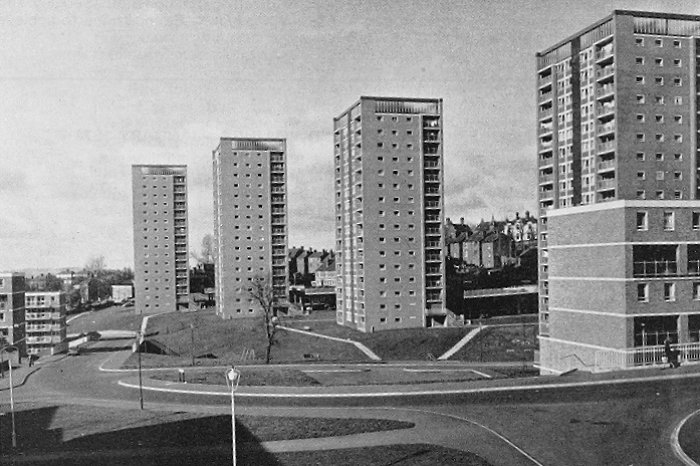
The Chapel Street redevelopment,
Brierley Hill. |
|
Dudley’s first tower block was
Wychbury Court flats, which officially opened on the
24th November, 1964. Wychbury Court was a 16 storey
tower block, containing 87 flats, in Westley Street. The
building survived for just over 36 years. It was
demolished by a controlled explosion on the 15th July,
2001, along with neighbouring Romsley Court.
As part of the slum clearance programme, the slums in
the Birmingham Street area were demolished. Fisher
Street had been widened in the 1930s and it became the
main road into the new bus station, which was built at
the end of Fisher Street and across Birmingham Street.
The new bus station was officially opened by the mayor,
Councillor Arthur Silcox on the 27th September, 1952.
The old bus station was replaced by the car park
alongside Birmingham Street, which is still there today.
The original bus station was demolished in 1984 and
replaced by the new bus station, which became fully
operational in 1987. The old bus station was on the
slope of the hill at right angles to the current bus
station, which was built on a level site along Fisher
Street. There were several accidents at the old bus
station when buses rolled back down the hill and injured
passengers.
From July 1927, until March 1967, trolley buses ran
into Dudley from Wolverhampton. The terminus was at
Stone Street Square. Midland Red also had a bus depot in
Dudley, in Birmingham Road, on the corner of Wolverton
Road. The depot, along with the other local bus services
was taken over by West Midlands Passenger Transport
Executive in 1973. It was closed in 1993 and demolished
in 1994 to make way for the Castle Gate traffic island,
on the town’s new southern bypass. The island was built
in 1997 and the bypass opened on the 15th October, 1999.

The bus terminus and car park in
Stone Street Square in the early 1960s.
In the 1950s, schoolchildren in
poor health could be sent to open air schools for up to
three months to help with their recovery. Places for
them were reserved at the Malvern Open Air School and at Astley Burf Camp, near Stourport, which was under the
control of Dudley Education Committee. Schoolboys could
also go on a free fortnight’s holiday to Rotary Boys’
House at Weston Super Mare, thanks to Dudley Rotary
Club. The children greatly benefitted from their time
away.

High Street and the Market Place
before redevelopment. From an old postcard. |
|
There were several extreme weather
events in the area. On Wednesday the 7th June, 1950,
over half an inch of rain fell in 45 minutes and
hailstones measuring about half an inch across, fell at
Netherton. St. Peter’s Road was about two feet deep in
water and houses in St. Thomas’s Road suffered water
damage to their roofs. Everything inside was soaked as
water rushed through them. Some chimneys were struck by
lightening and manhole covers were forced-up and broken.
In March, 1952 there were heavy snowfalls and blizzard
conditions, along with drifting snow. On the 14th June,
1954, heavy rainstorms caused flooding in the Dudley
Wood area, leading to Mousesweet Brook overflowing into
St Anne’s Road.
In 1958 work began on Bishop Milner
Roman Catholic School, Burton Road. It could cater for
up to 600 pupils. The school was officially opened by
the Archbishop of Birmingham on the 21st September,
1960.
|
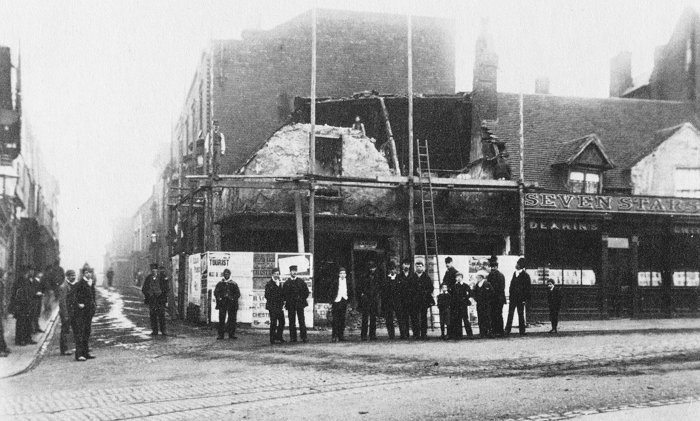
An early twentieth century
view of the northern end of Hall Street and part of
the Market Place. From an old postcard. |
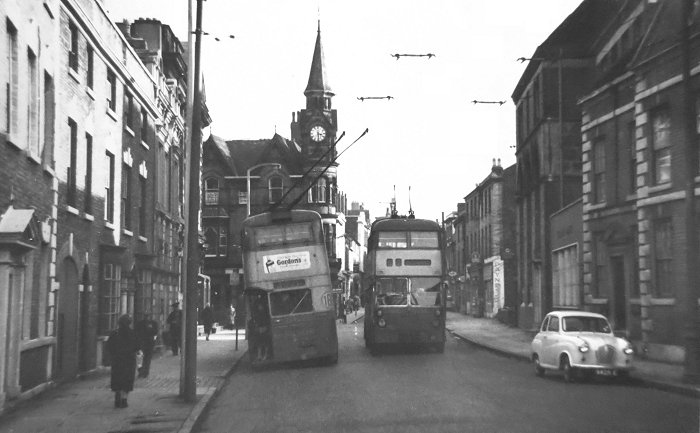
Wolverhampton Street in the early
1960s.
|
In 1962, much of the south side of
the town centre was designated as a clearance area, in
readiness for the development of a new shopping
precinct. Many buildings in King Street were demolished,
including some grand early 19th century houses, the
impressive Green Dragon pub, on the corner of Flood
Street and the Salvation Army citadel. Buildings in the
northern end of Hall Street were also demolished in
readiness for the building of Birdcage Walk. Other
casualties included the Woolpack and Stanton's music
shop in Castle Street, along with the Dudley Arms, the
Brown Lion, the Seven Stars and several fine shops in
the Market Place. Beaconsfield House, the birthplace of
Brooke Robinson, in Upper High Street, also disappeared.
On the 1st April, 1966, under the
terms of the 1958 Local Government Act, Dudley County
Borough became part of Staffordshire and took over
Sedgley, Brierley Hill, Coseley and
part of Amblecote.
Under the terms of the Local Government Act 1972,
Stourbridge became part of Dudley Metropolitan Borough.
Under the same Act, the West Midlands metropolitan
county, was formed on the 1st April 1974. It covers the
cities of Birmingham, Coventry and Wolverhampton, and
the boroughs of Dudley, Sandwell, Solihull and Walsall. In 1986, metropolitan
county councils were abolished under the terms of the
1985 Local Government Act and so Dudley became a unitary
authority, under the control of Dudley Metropolitan
Borough Council.
| |
|
|
|
|
Read
about Stourbridge
in the 19th Century |
 |
|
Organisations and Buildings at Stourbridge
in 1892 |
 |
| |
|
|
|
|
Work continued on the development
of the new shopping centre. The first part of the
project was the building of Birdcage Walk, named after a
glass aviary at the King Street end, which was stocked
with parrots from the zoo. At the opposite end, facing
Fisher Street is a sculptured frieze by Bainbridge
Copnall, depicting local industry and education.
Birdcage Walk was officially opened in April 1964.
|
|
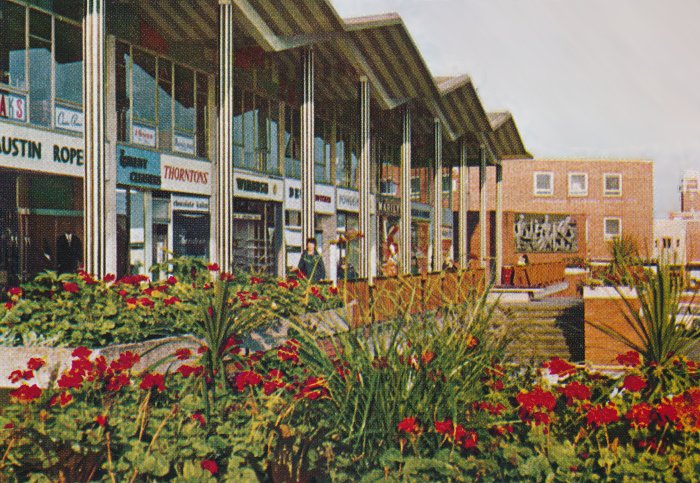
Birdcage Walk. |
|

Oldswinford Church and Rectory. |
|
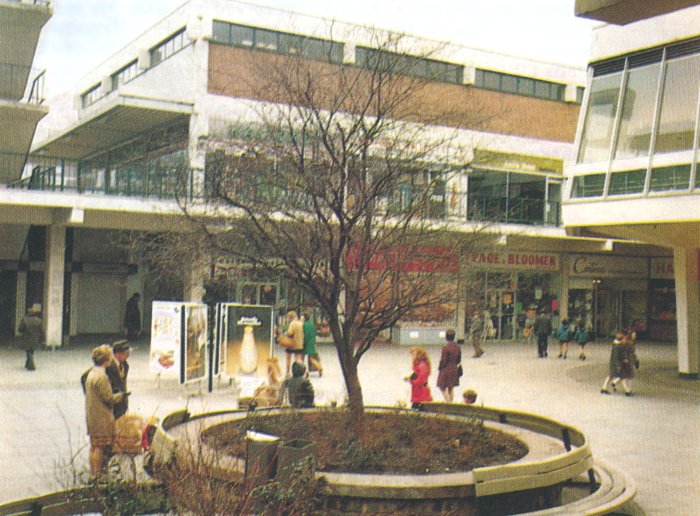
Halesowen Precinct. |
|
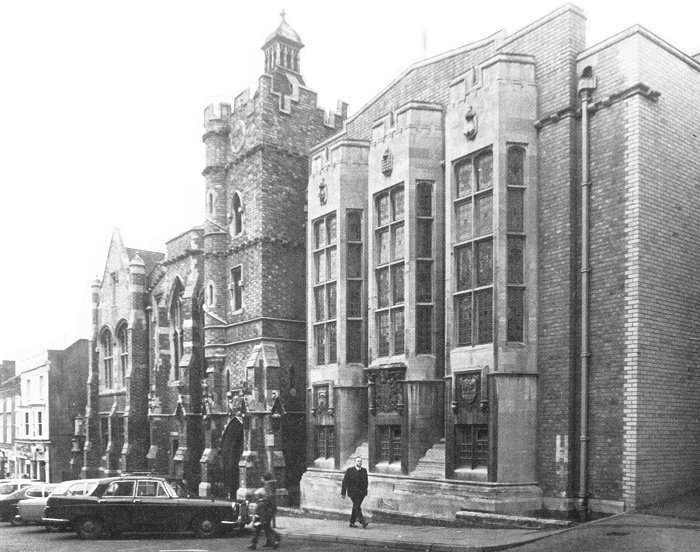
King Edward VI Grammar School,
Stourbridge. |
|
Demolition of the northern end of
Hall Street began in March 1965 and buildings in around
six acres of the town centre were compulsory purchased
by the council in readiness for demolition. The first
part of the shopping centre, completed in August 1967,
was the main thoroughfare, which replaced the northern
end of Hall Street. The 130,000 square feet shopping
centre was to be known as the Churchill Precinct,
celebrating Sir Winston Churchill. A 40 feet wide
screen, containing 17 glass panels, designed and built
by Bainbridge Copnall was erected 12 feet above the
shopping mall. In the centre was an image of Winston
Churchill dressed in ceremonial robes. The Churchill
Precinct was officially opened by Viscount Cobham on the
8th September, 1969.
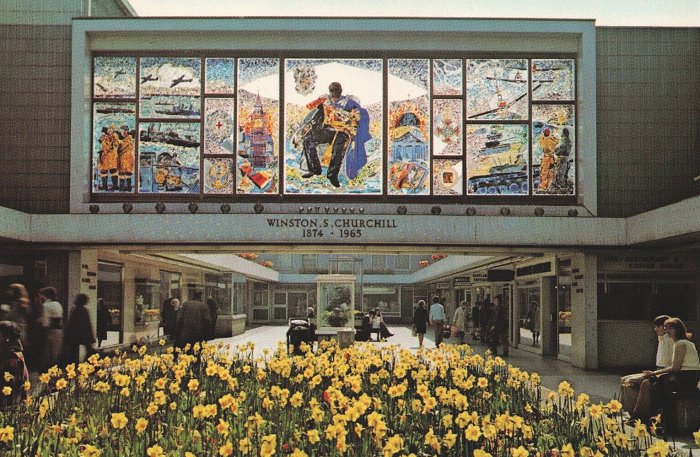
The Winston Churchill screen. From
an old postcard.
On the 28th October, 1972, the local
authority opened the Dudley Information Centre in the
precinct, which gave advice about local attractions and
activities and was an agent for the Heart of England
Tourist Board. The centre also sold books and guides about the
local area.
|
|
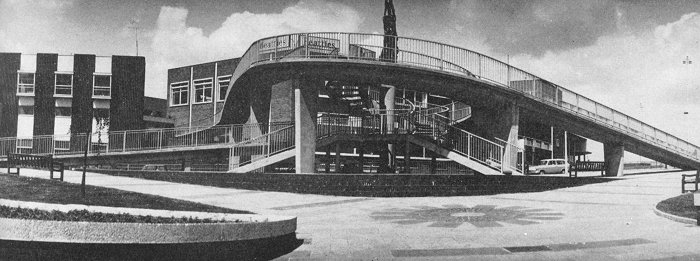
The pedestrian footbridge over
King Street. |
|
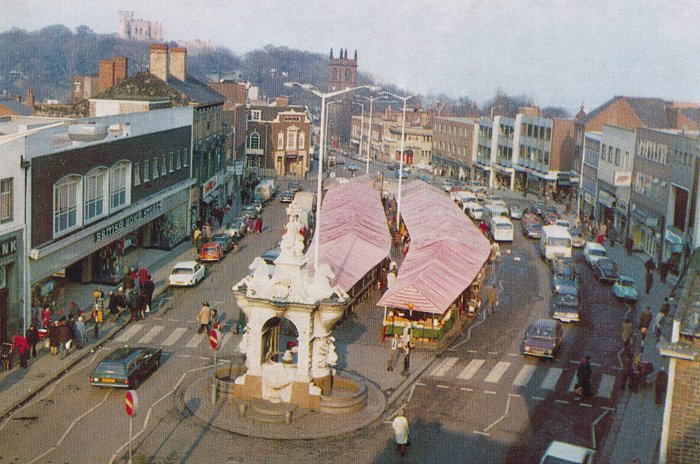
The Market Place. |
| There were some problems. In August
1970 a large piece of glass fell from the Churchill
screen, which cost £8,000 to repair. The screen was again
damaged by the wind-tunnel effect of the precinct and
was also vandalised. It was removed in 1991 and put into
storage. In 1973 work had to be carried out on the
floor, which was too slippery in wet weather and the
rooftop car park was unpopular with the staff in the
shops. In 1991, the council sold the shopping centre to LCP
Estates Limited, on condition that they refurbish the
already outdated buildings. The refurbishment was
carried out at a cost of £4 million. The work was
completed in 1993 and included a glass roof above the
precinct, automatic doors at the entrances, and a new
decor. |
|
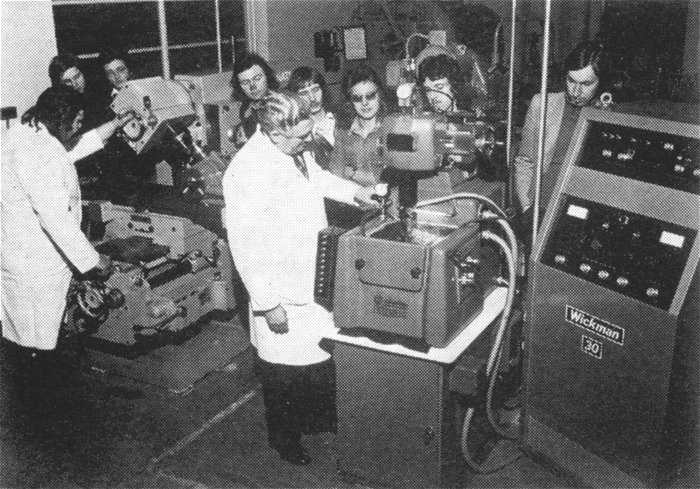
An engineering workshop at Dudley
Technical College. |
|

A Science laboratory at Dudley
College of Education. |

Dudley College, as seen from The Broadway.
| The Black Country Living Museum is one
of Dudley’s top tourist attractions, along with the zoo
and the canal tunnel. |
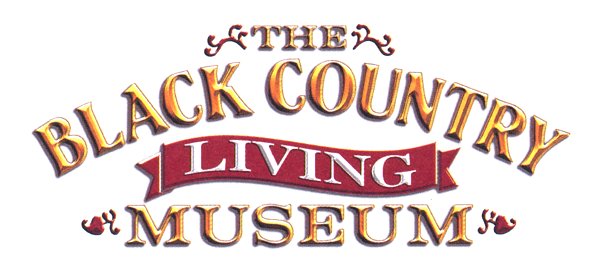 |
|
It began in 1968 when the idea
for a museum was promoted by members of the Black
Country Society, who established a trust fund at a
meeting in February, 1970. Dudley Council then set up a
Black Country Museum section in the museum department and developed the
idea of an open air museum to preserve and record the
region's heritage.
In 1973, a 26 acre site was purchased
alongside Tipton Road that had been used for coal mining
and sewage treatment. The site contained a canal that
ended at some limekilns. Initially there was much
clearing-up to be done on the site and many businesses
and organisations gave large sums of money towards the
project. The project rapidly got underway thanks to the
efforts of the museum's first director and chief
executive, Ian Walden, who was in charge for almost 34
years.
By the mid 1970s work had begun on
a typical Black Country village containing many
buildings, some of which were demolished and moved to
the site to be re-erected. The museum opened to the
public in 1978. The village has a wide variety of shops,
houses, a school, a chapel, a pub and industrial
buildings. It depicts life in the Black Country up to
the 1920s.
|
|
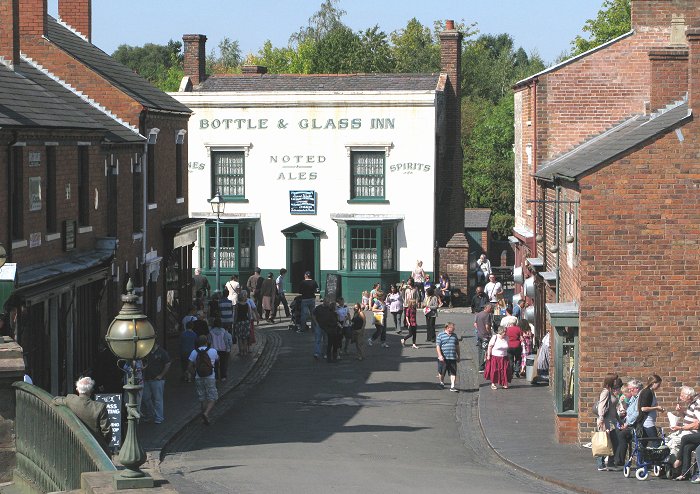
A busy day in the village. |
|

An early view of Emile Doo's
chemist shop. |
|
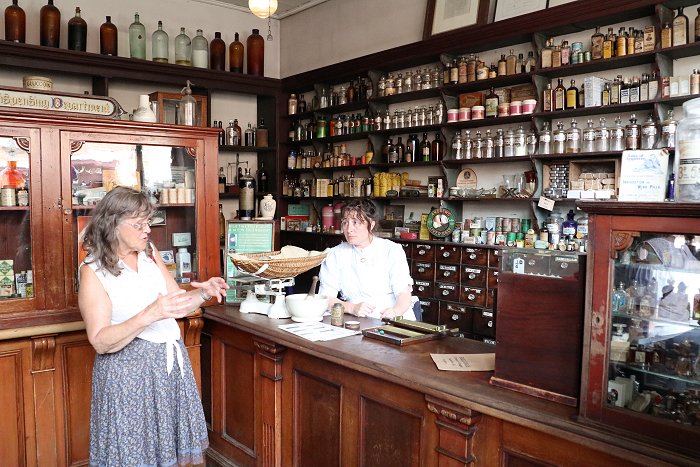
Emile Doo's chemist shop, as it is
today. |
|
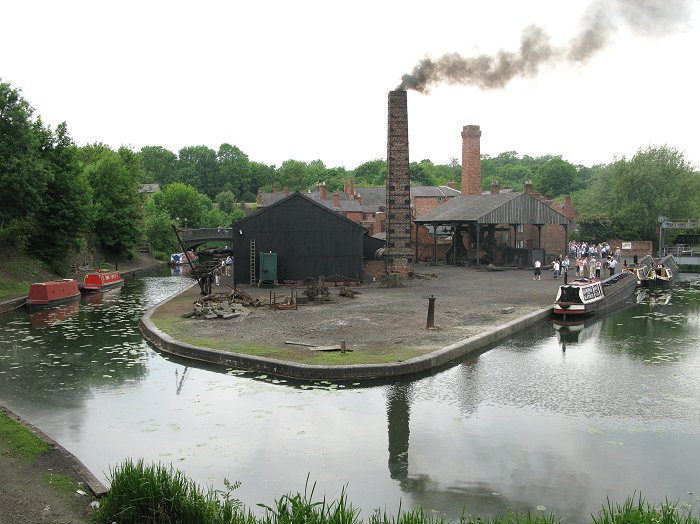
The canal and some of the museum's
narrow boats. |
|
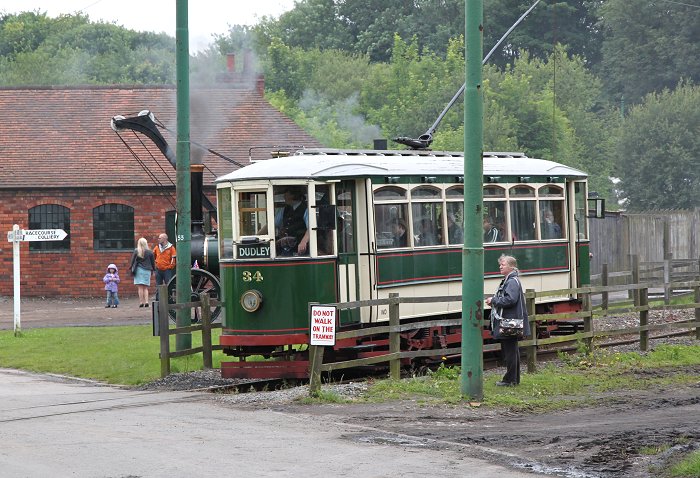
The Wolverhampton District
Electric Tramways Company, tram number 34. |
| The
museum also has a coalmine, a working Newcomen steam
engine, buses and trams, a large collection of Black
Country made vehicles, a boat dock and boat repair
facilities alongside the canal, with a collection of
narrow boats, a cinema, a bakehouse, a fish and chip
shop, a rolling mill, a tram depot and a lifting bridge
over the canal. There is also a steel trap works, a nail
shop, a forge and a chain maker’s shop. Until recently
there was also a funfair. |
|

The Newcomen mine pumping engine. |
|
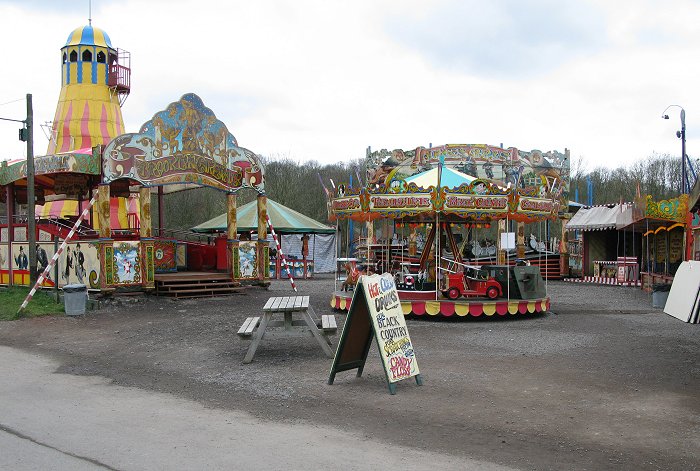
The popular funfair, that was at
the museum until recently. |
|
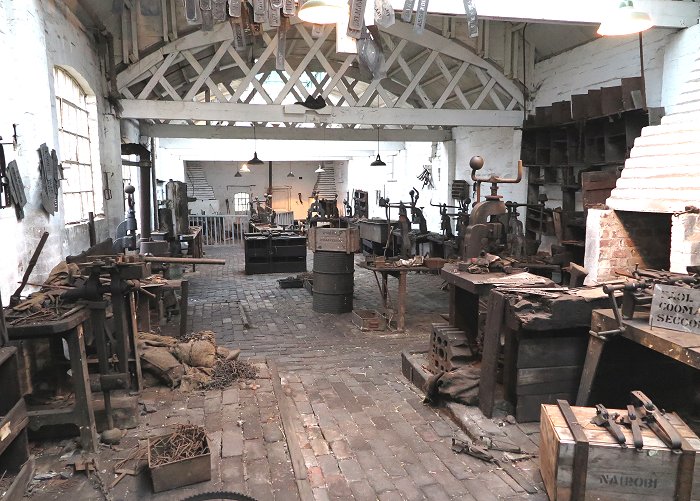
Sidebotham's steel trap works,
from Rookery Street, Wednesfield. |
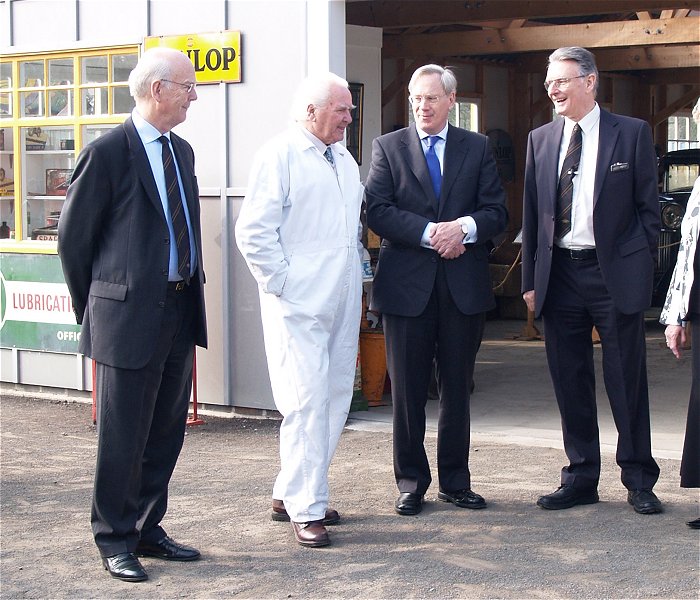
The official opening of Conway
Garage on the 20th March, 2009. Left to right: John
Hughes, Ray Jones, The Duke of Gloucester and Ian
Walden. |
|
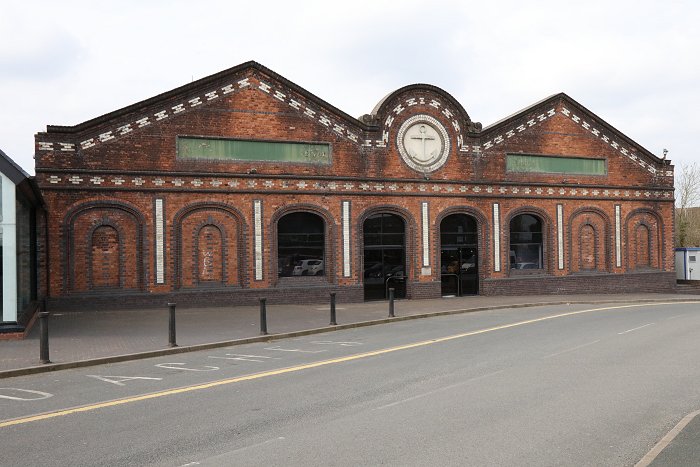
The frontage from John Russell &
Company Limited's Old Patent Tube Works, from
Wednesbury. |
|
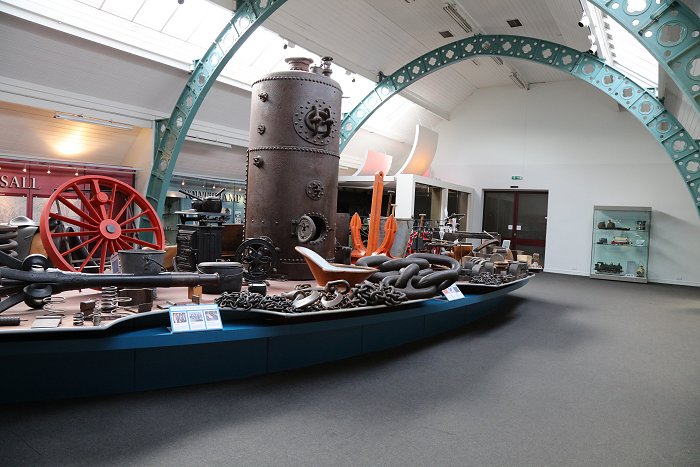
The original display in Rolfe
Street Baths, hall one. |
| In 2009 and 2010, other buildings
were added to bring the village forward in time to the
1930s, including a variety of shops, a second fish and
chip shop, house rooms on the first floor, the Cradley Heath Workers’ Institute
and café, a park and Conway Garage. There are many very
helpful museum guides in the various buildings and also buses and
trams to transport visitors around the site. The new
shops were officially opened by Carl Chinn on the 16th
July, 2010, in 'Old Birmingham' Road. |

Some of the new shops. Left to
right: Hartill's motorcycle shop, Preedy & Sons
tobacconists, Griptons wireless store. |

The other new shops can be seen on
the hill, above the village. Left to right: Hobbs &
Sons fish and chip shop, H. Morralls gentlemen's
outfitters, and Humphrey Brothers builder's
merchants. |
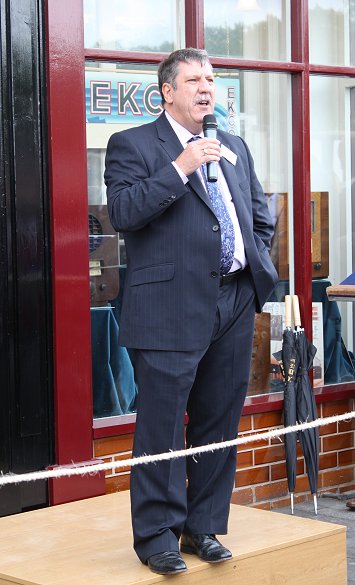 |
|
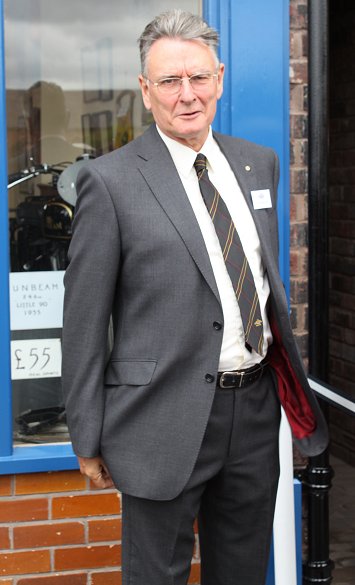 |
|
Carl Chinn. |
|
Ian Walden. |
|
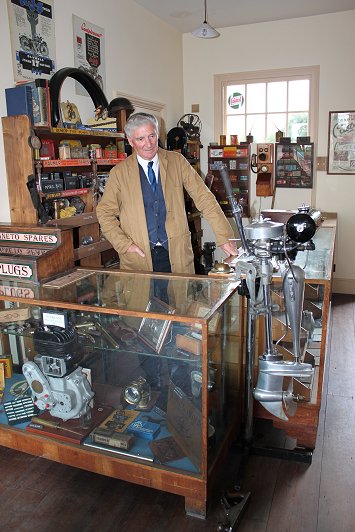 |
|
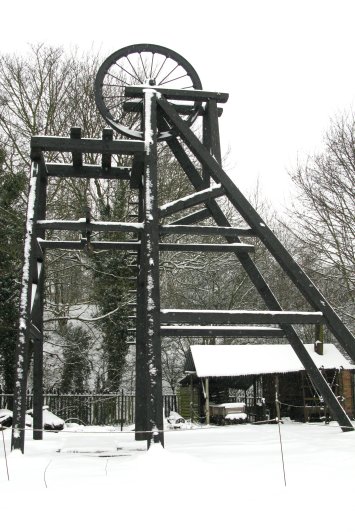 |
|
Inside Hartill's
motorcycle shop. |
|
Racecourse Colliery pithead on a snowy day. |
|
|
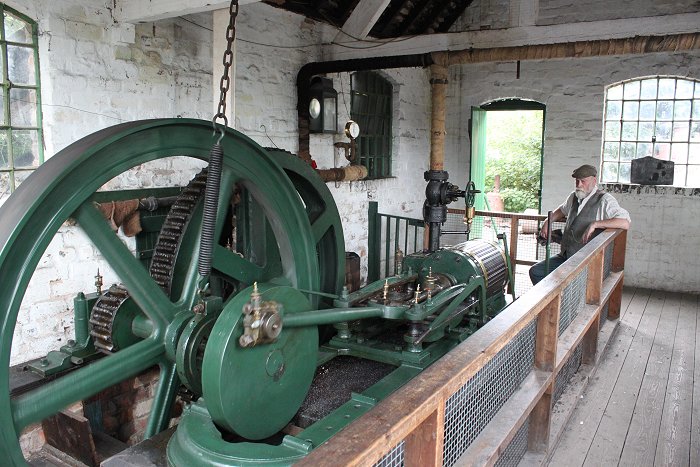
Racecourse Colliery winding
engine. |
|

The rolling mill. |
| Ian Walden retired on Saturday the 25th July, 2009,
after nearly 34 years. The museum's growth and much of
its success was down to Ian's hard work. He was replaced
by Andrew Lovett. On the 16th February, 2012, the
museum's collection was awarded designated status by
Arts Council England. It is now run by the Black Country
Living Museum Trust, a registered charity. The latest
project, called Forging Ahead will see the erection of
many buildings, some original and some replicas, to
allow the museum to tell the story of the Black Country
up the 1960s. |
|
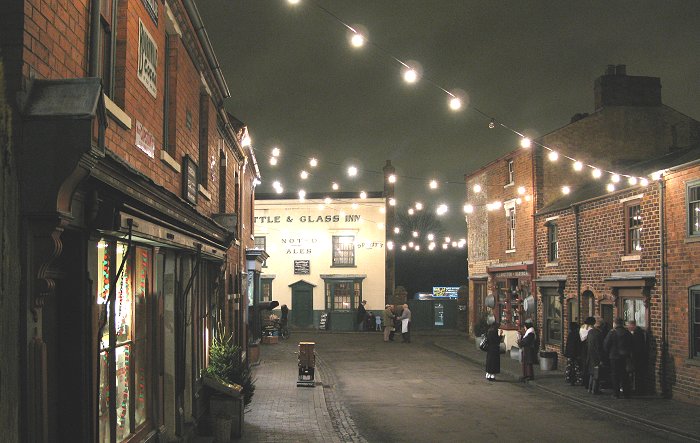
The village at night. |
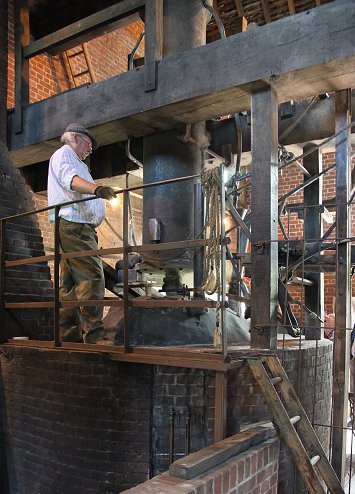 |
|
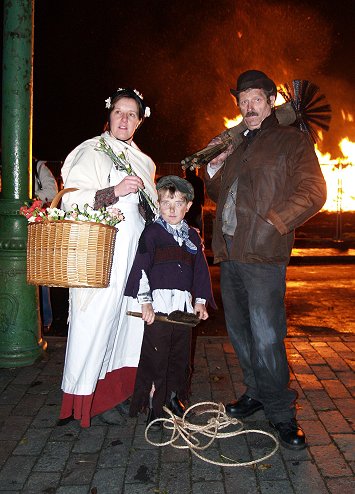 |
|
Operating the Newcomen engine. |
|
Bonfire night, 2007. |
|
|
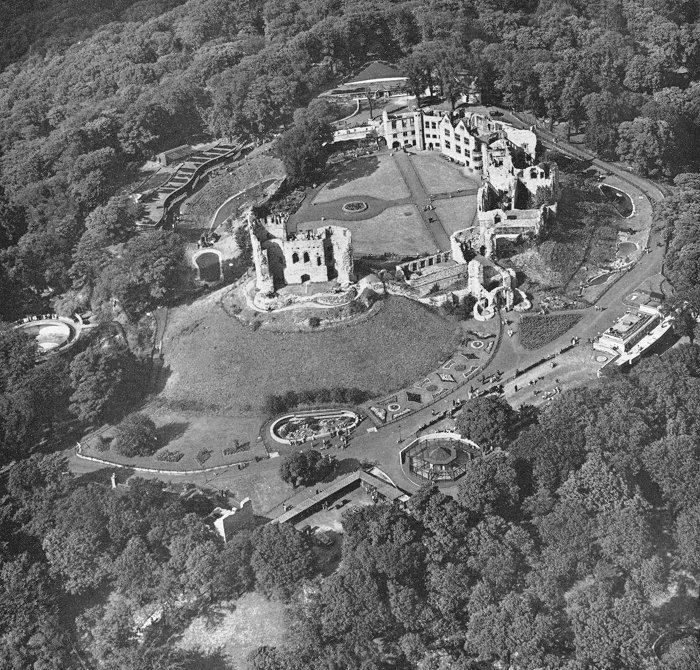
Dudley Zoo and Castle. |
|
Another museum in Dudley is the
Mushroom Green Chain Shop, which was saved thanks to the
efforts of the Black Country Society. It was restored in
early 1970s and completed in 1977. It is open to the
public on the second Sunday of each month from April to
October and gives demonstrations of chain making. It is
run by volunteers.
The borough's municipal housing schemes
continued at a rapid rate. In 1974 the number of council
dwellings was as follows: Dudley, 11,973; Brierley Hill,
9,035; Sedgley, 3976; Coseley, 2,240; Halesowen, 5,045;
Stourbridge, 5,762.
Total - 38,031.
| |
|
| View the
Entry for Dudley in the Birmingham and
District Trades Directory for 1961/62 |
 |
| |
|
Marsh & Baxter Limited
Marsh & Baxter Limited was founded
in Brierley Hill by Mr. Alfred Marsh. It began after he
bought a pork butcher's shop in High Street, Brierley
Hill, in 1867. He established his ham curing and sausage
manufacturing business in 1871.
The firm cured ham, at a time when
hams were only cured in the winter and early spring,
before going into storage. There was always a high
demand in the summer when demand often exceeded supply.
To overcome the problem, Mr. Marsh became one of the
first people in the UK to use refrigerated storage.
|
|
In 1912, Mr. Marsh acquired A. R.
Baxter’s business at Dale End, Birmingham, and
established the private company, Marsh & Baxter Limited.
Alfred Marsh died in 1918 and after World War One, the
firm absorbed a number of smaller businesses, including
C. & T. Harris (Calne) Limited. It became famous as a
producer of York hams, Wiltshire bacon, sausages, pork pies, meat pies and cooked meats.
In 1962 the firm was taken over by
FMC (Falstock Marketing Corporation) and in 1963, due to
redevelopment, A. R. Baxter’s premises in Birmingham,
was closed and a fine new factory was built in Castle
Bromwich.
In the mid 1970s, the firm had 50
retail shops in the Midlands and delivered its products
throughout the Midlands and South Wales. The products
were also sold in many other shops and supermarkets and
were exported to other countries.
The Brierley Hill factory closed in
December 1978. The site is now occupied by the Moor
Shopping Centre, High Street, Brierley Hill.
|
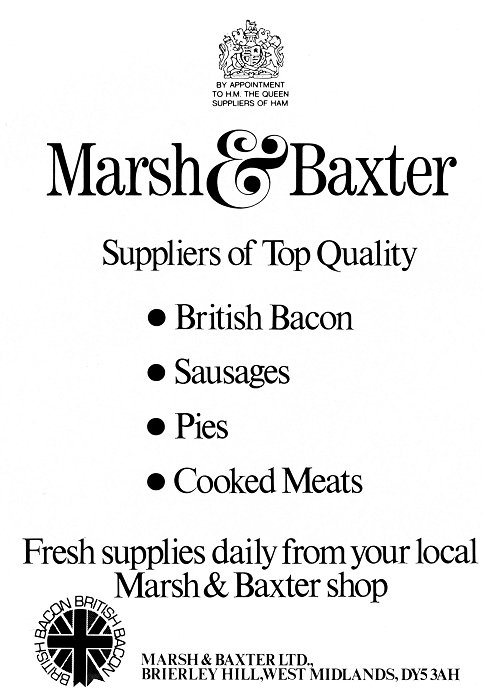
An advert from 1975. |
 |
|
 |
|
 |
Return to
World War 2 |
|
Return to
the contents |
|
Proceed to
Recent Times |
|